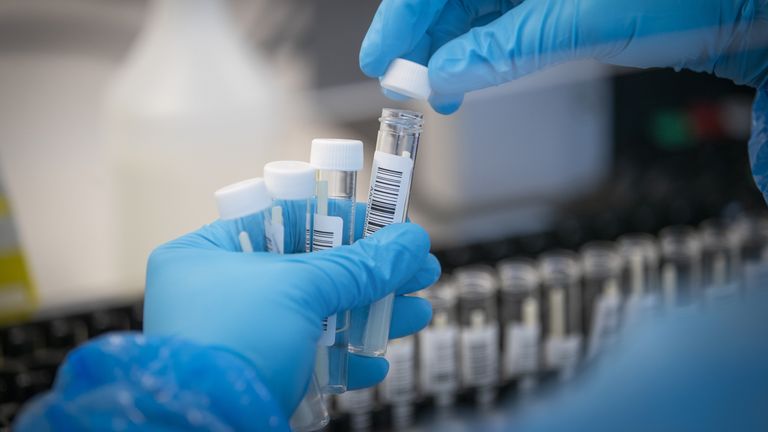COVID-19: Steep rise in coronavirus cases as reinfections included for first time since start of pandemic
For the first time since the start of the pandemic, reinfections in England and Northern Ireland are now being included on the daily COVID dashboard.
Tuesday 1 February 2022 16:31, UK
Another 92,368 coronavirus cases were reported for the UK on Monday - a steep rise on the previous day due to a reporting method change.
Reinfections have never been included in daily figures for Northern Ireland, Scotland and England (they have in Wales if the positive test came after 42 days) - meaning people who caught the virus for a second time were not included.
However, for the first time since the start of the pandemic, reinfections in England and Northern Ireland are now being included on the daily COVID dashboard.
COVID news live - updates from the UK and across the globe
What has changed?
Repeat positive tests were not previously included in the data.
The change, which was implemented for Northern Ireland and England from yesterday, means people will be counted if they test positive at least 90 days after their last test.
Data for Scotland will also be included in the coming weeks, while reinfections in Wales will soon be counted using the 90-day timescale.
What does this mean for daily case numbers?
The reporting method change resulted in a significant spike of cases.
Monday's figure came after 52,295 cases were reported on Sunday - the lowest figure since 14 December before Omicron had peaked.
As for the daily deaths figure, this was 51 yesterday, giving a total of 155,754 deaths within 28 days of a positive test.
The total number of deaths with COVID on the death certificate currently stands at 176,813.
Under-reporting
The number of new cases reported by the government has always been lower than the level estimated by the Office for National Statistics, but the gap has become wider since the arrival of the Omicron variant.
High levels of under-reporting will still be affecting the government's daily figures, meaning the true volume of cases in the UK is increasingly unclear.
The dashboard numbers are limited to all positive lab-confirmed PCR test results in the UK, plus positive lateral flow tests in Northern Ireland and, in England, any positive lateral flow tests not followed by a negative PCR test taken within 72 hours.
Although the dashboard will now also include figures for COVID-19 reinfections in England and Northern Ireland - this data will still be affected by how many people are reporting their test results.
Follow the Daily podcast on Apple Podcasts, Google Podcasts, Spotify, Spreaker
Reinfections spiked during Omicron wave
Professor Steven Riley, director general of data and analytics at the UK Health Security Agency (UKHSA), said: "Reinfection remained at very low levels until the start of the Omicron wave.
"It is right that our daily reporting processes reflect how the virus has changed.
"We continue to see downward trends in case numbers and incidence of illness as we work to reduce the impact of the pandemic on our day-to-day lives.
"With vaccination still a great defence against infection and illness, please get jabbed as soon as possible."






